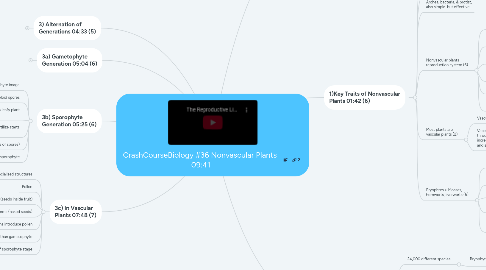
1. Topic Index (6)
1.1. Table of Contents
2. 1)Key Traits of Nonvascular Plants 01:42 (6)
2.1. Single algae species moved to land about 1.2 billion years ago
2.1.1. Their sex life evolved from algae and the basis of every plant today
2.2. 1/2 million plant species today
2.2.1. 475 MYA
2.2.1.1. Liverworts, Mosses, Hornworts
2.3. Archea, bacteria, & protist, also simple but effective
2.4. Nonvascular plants reproduction system (6)
2.4.1. Don't have vascular plant roots, stems, and leaves or way to move water/nutrients around
2.4.2. Rely on osmosis through cell walls to move water / nutrients around
2.4.3. They keep it simple and small, no specialized conductive tissues
2.4.4. Limited growth potential because they don't have structure to move anything far
2.4.5. Need water for reproduction
2.4.6. true plants: multi-cellular, cellulose cells, photosynthesis
2.5. Most plants are vascular plants (2)
2.5.1. Vascular plants have roots, stems, and leaves
2.5.2. Vascular system can move water & nutrients throughout a bigger plant because of increased support structure wood in primary and secondary growth
2.5.2.1. Primary Growth
2.5.2.2. Secondary Growth
2.6. Bryophtes > Mosses, hornworts, liverworts (5)
2.6.1. Take water & nutrients directly through their permeable membranes depending on osmosis and diffusion
2.6.2. Limited Growth because they lack vascular and woody support tissue
2.6.3. Keep it simple and small
2.6.4. Need water to reproduce
2.6.4.1. Male gametophyte swims with tail to female egg
2.6.5. Are true plants they have cellulose cell walls and photosynthesis
3. 2) 3 Phyla of Bryophytes 02:52 (8)
3.1. 24,000 different species
3.1.1. Bryophytes weblink
3.1.1.1. named after their leaf-like shape
3.1.1.2. Wort means herb
3.1.1.3. Don't know which of these primitive plants evolved first
3.2. Mosses
3.2.1. Bryophyta Division
3.2.1.1. 15,000 species
3.3. Hornworts
3.3.1. Anthocerophyta Division
3.3.1.1. 100 species
3.4. Liverworts
3.4.1. Marchantiophyta Division
3.4.1.1. 9000 species
3.5. Named after their leaf appearance
3.6. Very complicated reproduction
3.6.1. These Bryophtes gave rise to all other later plant forms
3.7. Raindeer moss is not a moss but a lichen
3.8. Spanish moss is not a moss or even a lichen but is a vascular plant
4. 3) Alternation of Generations 04:33 (5)
4.1. alternate generation: two forms over their lifestyle
4.2. Algae used this first
4.2.1. Both stages look similar
4.3. Land plants don't even share the same reproductive strategy
4.3.1. Gametophyte > haploid gametes > eggs & sperms
4.4. Animals different, diploid mostly, haploid only for brief reproduction phase using 1 haploid cell from each parent for fertilization
4.5. Alternation of Generations image
4.5.1. Alternation of generations
5. 3a) Gametophyte Generation 05:04 (6)
5.1. These are the leaves
5.2. antherida male
5.2.1. antheridia
5.3. archegonia female
5.3.1. archegonia
5.4. require water
5.5. Calyptera
5.5.1. capyptera
5.6. Bryophyte sperm like human sperm but 2 spiral flagella
6. 3b) Sporophyte Generation 05:25 (6)
6.1. diploid sporophyte image
6.1.1. sporophyte
6.2. sporangium capsule makes haploid spores
6.2.1. sporangium
6.3. gametophtes are the big green leafy plant parts
6.3.1. gametophytes
6.4. After gametophyte haploid egg & sperm fertilize starts the diploid sporophyte generation
6.5. Protonema (germination like phase of spores)
6.5.1. Protonema
6.6. sporophyte
6.6.1. Sporophyte
7. 3c) In Vascular Plants 07:48 (7)
7.1. Have specialized structures
7.2. Pollen
7.3. Angiosperms (seeds inside fruit)
7.3.1. angiosperms
7.4. Gymnosperms (naked seeds)
7.4.1. Gymnosperms
7.5. Gymnosperms introduce pollen
7.5.1. Pollen
